Persimmon Insect Pests
Persimmon Insect Pests
Mealy bug
Biology:- Egg: The long-tailed mealybug reproduces sexually, each female laying 75-200 eggs (the number being dependent on the host plant)
- Nymphs: The nymph is similar to the larger adult female except that the filaments around the edges are shorter.
- Adult: The body of the female is yellow, with a dorsal brownish stripe and covered by white waxy dust. The body is elongated, 2.5-4.0 long, with 17 pairs of marginal wax filaments. The anal pair, which is longest, may exceed the pest’s entire length (hence its vernacular name). Antennae 8-segmented.
Life cycle:
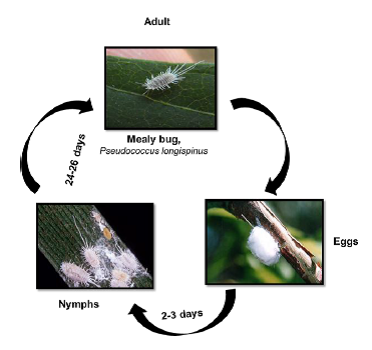
Damage symptoms:
- Longtailed mealybugs feed by sucking out plant sap from leaves and stems. Honeydew and sooty mold further disfigure infested plants, which may eventually be killed.
- These pests also secrete a fluffy white wax which also detracts from the appearance of infested plants.
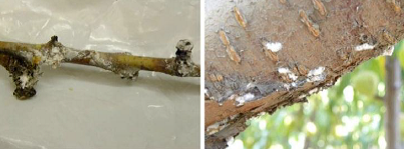
Natural enemies of mealybug:
- Parastioids: Anagyrus nigricornis
- Predators: Brown lacewing
Scales
Biology:- Egg: female scale can lay about 1,000 or more eggs, and populations can build quickly.
- Crawler: Crawlers hatch from early June through mid-July. Crawlers move to the leaves where they settle near leaf veins. In late August, crawlers move back to the twigs. Newly hatched crawlers are initially white and become yellow with age.
- Adult: Male scale mate with females in early spring and then die
Life cycle:
Damage symptoms:
- The large number of new crawlers produced each generation can
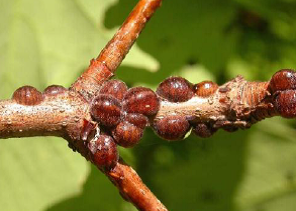 lead to
lead to - copious honeydew production and a high probability that sooty mold fungus will
- disfigure host plants and foliage of adjacent plant species. Dieback of limbs and
- branches may become apparent, and the infested plant may become weakened.
Predators: Minute pirate bugs, lacewings, ladybird beetles, predaceous midges and parasitoid wasps feed on these scale insects.
Fruit flies
BiologyDevelopment from egg to adult under summer conditions requires about 16 days. The mature larva emerges from the fruit, drops to the ground, and forms a tan to dark brown puparium. Pupation occurs in the soil. About nine days are required for attainment of sexual maturity after the adult fly emerges. The developmental periods may be extended considerably by cool weather. Under optimum conditions, a female can lay more than 3,000 eggs during her lifetime, but under orchard conditions from 1,200 to 1,500 eggs per female is considered to be the usual production. Apparently, ripe fruit are preferred for oviposition, but immature ones may also be 34 attacked.
- Egg: The white, elongate and elliptical egg measures about 1.17 x 0.21 mm and has a chorion without sculpturing
- Larva: The third-instar, which has a typical maggot appearance, is about 10 mm in length and creamy white. The only band of spinules encircling the body is found on the first segment. The external part of the anterior respiratory organs, the spiracles, located one on each side of the pointed or head end of the larva, has an exaggerated and deflexed lobe at each side and bears many small tubercles. The caudal segment is very smooth. The posterior spiracles are located in the dorsal third of the segment as viewed from the rear of the larva.
- Pupa: The mature larva emerges from the fruit, drops to the ground, and forms a tan to dark brown puparium about 4.9 mm in length.
- Adult: The adult, which is noticeably larger than a house fly, has a body length of about 8.0 mm; the wing is about 7.3 mm in length and is mostly hyaline. The color of the fly is very variable, but there are prominant yellow and dark brown to black markings on the thorax. Generally, the abdomen has two horizontal black stripes and a longitudinal median stripe extending from the base of the third segment to the apex of the abdomen. These markings may form a T-shaped pattern, but the pattern varies considerably. The ovipositor is very slender and sharply pointed.
Life cycle:
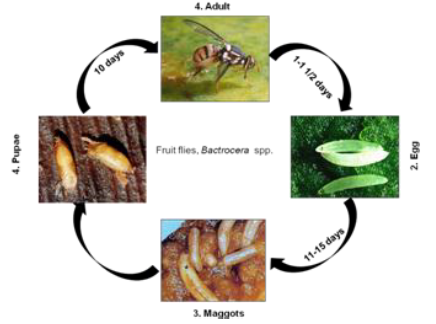
Damage symptoms:
- The damage to crops caused by fruit flies result from 1)
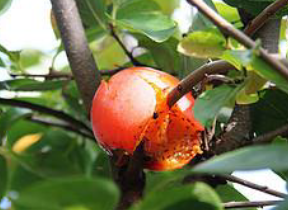 oviposition in fruit and soft tissues of vegetative parts of certain plants, 2) feeding by the larvae, and 3) decomposition of plant tissue by invading secondary microorganisms.
oviposition in fruit and soft tissues of vegetative parts of certain plants, 2) feeding by the larvae, and 3) decomposition of plant tissue by invading secondary microorganisms. - Larval feeding in fruits is the most damaging. Damage usually consists of breakdown of tissues and internal rotting associated with maggot infestation, but this varies with the type of fruit attacked. Infested young fruit becomes distorted, callused and usually drop; mature attacked fruits develop a water soaked appearance. The larval tunnels provide entry points for bacteria and fungi that cause the fruit to rot. When only a few larvae develop, damage consists of an unsightly appearance and reduced marketability because of the egg laying punctures or tissue break down due to the decay.
- Parasitoids: Tiny wasps (e.g. Bracon spp.)
- Predators: Rove beetles, weaver ants, spiders and birds and bats
Twig girdlers borers
Biology:- Egg: The female beetle lays her yellow disk-like wrinkled eggs in cracks in the bark of trees, nearly always selecting a tree that is unhealthy, or a spot on a healthy tree where the bark has been injured, i.e. by sunscald or a bruise. The eggs are laid from May to August
- Larva: Varies from yellowish white to yellow and 15 to 18 mm long when mature. Thoracic segments--not head, as name implies--greatly enlarged and flattened. Abdomen bent back, making larva look like hook when exposed in feeding burrow.
- Pupa: The pupae overwinter within the galleries where they transform into adults which emerge from late spring through summer.
Life cycle:
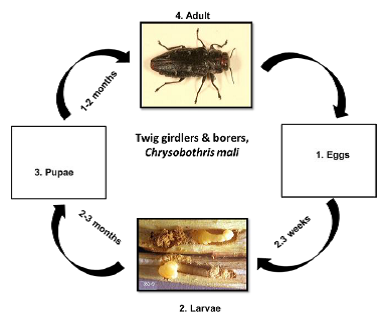
Damage symptoms:
Natural enemies of twig girdlers borers:
Adult feeding may cause some defoliation, but the major damage to the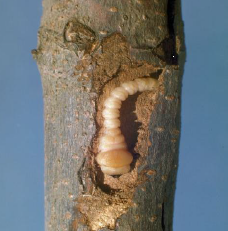 plant is caused by larval feeding which creates galleries (mines) between the bark and the wood. The galleries are usually filled with coarse, excelsior-like fibers. The galleries, which nearly always begin on the sunny side of the tree, may extend completely around the tree thus girdling and killing the tree or infested branches. A full-grown larva may bore from 1 to 2 inches deep in the wood of the tree. Bark exterior to the galleries or mines may die and peel off. Sap may exude from these dark colored dead areas of bark. The darkened areas of bark and fine bits of sawdust protruding through the bark indicate the presence of wood boring larvae.
plant is caused by larval feeding which creates galleries (mines) between the bark and the wood. The galleries are usually filled with coarse, excelsior-like fibers. The galleries, which nearly always begin on the sunny side of the tree, may extend completely around the tree thus girdling and killing the tree or infested branches. A full-grown larva may bore from 1 to 2 inches deep in the wood of the tree. Bark exterior to the galleries or mines may die and peel off. Sap may exude from these dark colored dead areas of bark. The darkened areas of bark and fine bits of sawdust protruding through the bark indicate the presence of wood boring larvae.
- Parasitoids: Spathius floridanus, Atanycolus charus, Atanycolus femoratae, Atanycolus rugosiventris.
- Parasite: Pediculoides ventricosus
Persimmon psylla
Biology:- Egg: The elongate-ovate eggs of the persimmon psylla are found lying flat on the succulent growth of the persimmon. They are about .01 inch in length with the larger end curved down and attached while a short pointed portion curves away from the support at the smaller end. The eggs are pale white, turning to yellow or brownish yellow before hatching. They are laid singly, usually rather uniformly arranged in rows along the margin of the leaf, on the surface of the leaf, or on the petiole or stem. They may also be found very generally scattered over these areas. Sometimes they are found scattered or grouped in the axils of the leaves or around dormant buds.
- Nymph: The nymph is fringed on the margins with long hairs as in other species of Trioza. It is covered with a white powder.
- Adult: The adult ranges in length from 3.5 mm to 4.5 mm. Its color is generally shining black except that the middle and hind tibiae, all tarsi, general processes, and antennae except for the tip, are whitish. Key characters include the hind tibiae with three inner apical spines, antennae distinctly longer than width of head, top of head and thorax sparsely covered with long pubescence, black color, and the medial cell of forewing much larger than cubital.
Life cycle:
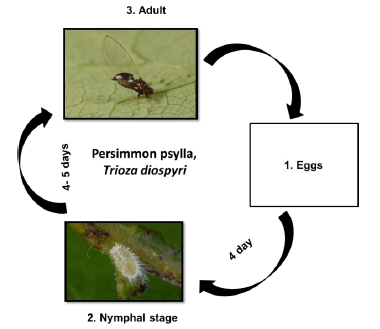
Damage symptoms:
- The persimmon psylla causes leaves and shoots to become
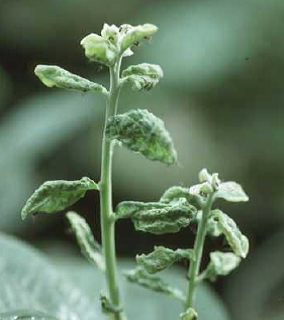 stunted, twisted, and curled. The female psylla lay eggs at the margin of the underside of the leaf. When the nymphs hatch they feed and inject toxins which cause the leaf to curl (pocketing) around them, making control difficult.
stunted, twisted, and curled. The female psylla lay eggs at the margin of the underside of the leaf. When the nymphs hatch they feed and inject toxins which cause the leaf to curl (pocketing) around them, making control difficult. - Nymphs are found in the pocketings, together with white waxy filaments, cast skins, and "honeydew" which ants will often feed on.
- Although a light infestation would have little effect on tree vigor, homeowners would become concerned, especially if the infestation became moderate to severe. Perhaps the most dollar loss occurs to nurserymen who either apply preventive sprays or find tree values lowered when leaves of these trees become infested and distorted.
- Parasitoids: Syrphid, ladybird beetles
- Parasite: Psyllaephagus trioziphagus
IPM for Persimmon
To know the IPM practices for Persimmon, click here.
Source: NIPHM Directorate of Plant Protection, Quarantine & Storage
Last Modified : 4/2/2020
This topic covers the information related to insec...
This topic covers information about Description of...
This topic provides information about Curryleaf Pe...
This topic covers information about Amla Insect Pe...

